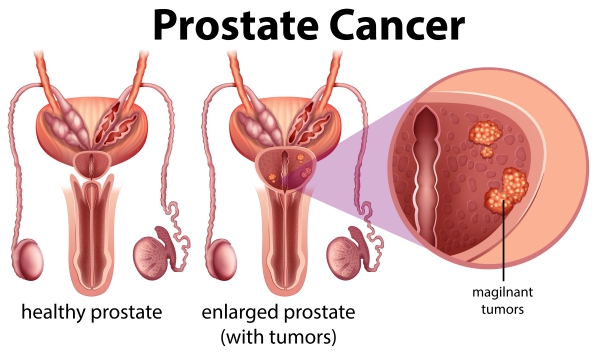What is prostate cancer?
Prostate cancer is a cancer which affects the prostate gland. The prostate gland is a gland that is located below the bladder and is unique to men. It produces a liquid called semen. The prostate gland surrounds the urethra which is the tube that carries urine from your bladder out of your penis. This is why any enlargement of the gland can result in urinary symptoms such as frequent urination, blood in urine and decrease pressure of the urine stream. Furthermore, androgens, which are hormones that help to develop and maintain sexual characteristics, help the cancer cells to grow.
Prostate cancer is the second most common cancer in men worldwide. In the United States, it is the most common cancer affecting men and the second most common cause of death in men. The American Cancer Society estimates that around 192,000 new cases of prostate cancer will be diagnosed by 2020. Usually men above the age of 50 years are affected. In addition, blacks are 2 times more at risk of developing prostate cancer than whites.
What are the risk factors for prostate cancer?
There are several factors which can increase your risk of developing prostate cancer, these include:
- A family history of prostate cancer.
- Increasing age
- Being an African American
- Obesity

What are the signs and symptoms of prostate cancer?
People with early stage prostate cancer may not have any symptoms at first. Eventually, as the cancer continues to grow, causing compression of the urethra and bladder, the following signs and symptoms may ensue:
- Blood in urine (haematuria).
- Erectile dysfunction.
- Decrease pressure of the urine stream.
- Pelvic or back pain.
- The need to rush to the toilet (urinary urgency).
- Difficulty to start urination.
- Straining during urination.
- Sensation that not all urine in the bladder was removed during urination.

Making a diagnosis
The diagnosis of prostate cancer will involve your doctor taking a detailed history from you to know more about your symptoms at first. Then he/she will carry out a physical examination to look for signs of prostate cancer. Your doctor will do a digital rectal examination (DRE) during which he/she will insert a finger into your rectum to assess for the size and consistency of the prostate gland. However, 25-35% of prostate cancer will not be detected by DRE.
In addition, your doctor may order a Prostate specific Antigen (PSA) test. In prostate cancer the PSA level will be increased. PSA is a protein produced solely by the prostate gland. Usually, the PSA level should be repeated after a few weeks to verify if it is still elevated.

If ever the prostate is abnormal during DRE or the PSA level is elevated on more than 1 occasion, your doctor may request a biopsy of the prostate gland. In addition, Transrectal Ultrasound (TRUS) may be required if any abnormality is detected during DRE. TRUS is used to guide your doctor while taking the biopsy. The samples obtained are then sent to the laboratory for evaluation.
The staging of prostate cancer is based upon the Gleason score. A score less than 7 with a PSA level between 10–20 ng/ml means that there is cancer but it is likely non-aggressive. However, if the Gleason score is greater than 8 with a PSA level greater than 20 ng/ml, this indicates an aggressive cancer.
MRI can also be used to estimate the likelihood of prostate cancer id PSA results are equivocal.
Treatment of prostate cancer
The treatment of prostate cancer depends on your age and stage of the cancer. Treatment of prostate cancer includes:
- Androgen deprivation therapy (ADT): Gonadotropin-releasing hormone (GnRH) agonist and antagonist help to temporarily “turn off” the testicles’ production of androgen. As a result, the prostate will shrink. In addition, GnRH antagonists (Degarelix) are more rapidly acting than GnRH agonists (Leuprolide and goserelin). Side effects include decreased libido, hot flashes, increased risk of getting diabetes mellitus, loss of muscle and increase in body fat.
- Chemotherapy is a treatment given to slow down or stop the growth of the cancer cells. It is usually recommended in combination with ADT as an initial treatment for men with metastatic prostate cancer. Metastatic prostate cancer is when the cancer has spread outside of the prostate, affecting the bones or other organs. Drugs used in chemotherapy include docetaxel and cabazitaxel. Side effects include temporary hair loss, nausea and vomiting.
- Immunotherapy uses the body’s immune system to help fight against the cancer cells.
- Radiation therapy uses Radium-223 to treat metastatic prostate cancer. The radiation is targeted towards the pelvic bone to help relieve bone pain and extending life.
- Surgical treatment is called radical prostatectomy. It includes surgical removal of your prostate gland. The method is curative for those whose cancer has not spread beyond the prostate gland yet.
- Trans-urethral resection of the prostate (TURP) helps to increase the diameter of your urethra.
- Cryotherapy kills cancer cells by freezing them. It is used to treat prostate cancer that has not yet spread.

Complications of prostate cancer
If prostate cancer is left untreated, several complications may develop, such as:
- Erectile dysfunction: it can be either due to the cancer itself or as a consequence of surgery, hormone or radiation treatment. This condition may be treated using medication and vacuum devices.
- Urinary incontinence: this condition may arise due to prostate cancer or its treatment.
- Metastasis of the cancer: this is when the cancer spreads beyond the prostate gland to affect adjacent structures such as bladder, bone, and other organs or even into your bloodstream.

Prognosis
The prognosis of prostate cancer depends on the Gleason score, size of tumour and evidence of spreading. In addition, the PSA level and age at diagnosis can also help to predict the prognosis of prostate cancer. The 5-year survival rate for men with regional prostate cancer is 100%. However, the 5-year survival rate for those with metastatic prostate cancer is 30%.

Source:
Parveen, K. and Michael, C., 2017. Kumar & Clark’s Clinical Medicine. 9th ed. The Netherlands: ELSEVIER.
Chad, T., 2020. Prostate Cancer.
Kantoff, P., Taplin, M., and Smith, J., 2020. Clinical presentation and diagnosis of prostate cancer.
Kantoff, P., Taplin, M., and Smith, J., 2020. Initial staging and evaluation of men with newly diagnosed prostate cancer.
NHS. 2020. Prostate cancer.



